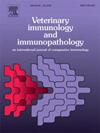抗臀击和非选择羊对羊蝇的先天免疫反应的特征
IF 1.4
3区 农林科学
Q4 IMMUNOLOGY
引用次数: 0
摘要
臀裂是影响产羊毛羊的主要寄生问题。虽然皮肤皱纹和粪便污染是公认的危险因素,但绵羊个体之间的易感性差异仍未得到解释。本研究比较了遗传选择的3岁美利奴母羊在短暂的铜露西莉亚幼虫攻击后的早期免疫反应与未选择的母羊的免疫反应。在14只羊(7只抗臀击羊和7只未选择的羊)背部的4个随机位置用铜乳杆菌卵攻卵。植入后31 h,从每只羊的4个感染部位和4个模拟部位(不含蝇卵的牙塞)采集皮肤活检,并使用免疫组织化学染色分析不同的细胞生物标志物。使用Milliplex羊细胞因子/趋化因子试验分析这些位点的局部细胞因子反应。在幼虫取食部位观察到白细胞的浸润,主要由中性粒细胞组成。淋巴细胞中表达T细胞标志物CD4、CD1、CD8、T19、γδ-T细胞以及B细胞标志物CD45R的数量明显高于模拟位点。促炎细胞因子IL-1α、IL-6、IL-17a和化学引诱剂IL-8、MIP-1α显著升高。这些结果表明,在短暂的幼虫攻击后,绵羊会产生选择性的先天免疫反应,这在臀击抵抗羊和非选择羊中是相似的,这表明在臀击抵抗羊中观察到的对蝇击的抗性不太可能主要由组织水平的局部先天免疫机制介导。本文章由计算机程序翻译,如有差异,请以英文原文为准。
Characterising the innate immune response in breech strike resistant and non-selected sheep to the sheep blowfly (Lucilia cuprina)
Breech strike is a major parasitic problem affecting wool-producing sheep. While skin wrinkles and fecal soiling are recognized risk factors, much of the difference in susceptibility between individual sheep remains unexplained. This study compared the early immune response of 3-year-old Merino ewes genetically selected to be resistant to breech strike to that of the non-selected ewes following a brief Lucilia cuprina larval challenge. Fourteen sheep (seven breech strike resistant and seven non-selected sheep) were challenged with L. cuprina eggs at four random sites on their back. Skin biopsies were collected 31 h post-implantation from the four infested and four mock sites (dental plugs without blow fly eggs) from each sheep and analysed using immunohistochemical staining for different cell biomarkers. A Milliplex ovine cytokine/chemokine assay was used to analyse the local cytokine response at these sites. An infiltration of leukocytes was observed at the larval feeding sites that predominantly comprised neutrophils. Significant increases in lymphocytes expressing T cell markers for CD4, CD1, CD8, T19, γδ-T cell, as well as the B cell marker CD45R, were observed compared to the mock sites. The pro-inflammatory cytokines IL-1α, IL-6, IL-17a, and chemoattractants including IL-8 and MIP-1α were significantly elevated in challenged sites. These results demonstrated a selective innate immune response in sheep following a brief larval challenge, which was similar in breech strike resistant and non-selected sheep, suggesting that the observed resistance to flystrike in the breech strike resistant flock is unlikely to be primarily mediated by local innate immune mechanisms at the tissue level.
求助全文
通过发布文献求助,成功后即可免费获取论文全文。
去求助
来源期刊
CiteScore
3.40
自引率
5.60%
发文量
79
审稿时长
70 days
期刊介绍:
The journal reports basic, comparative and clinical immunology as they pertain to the animal species designated here: livestock, poultry, and fish species that are major food animals and companion animals such as cats, dogs, horses and camels, and wildlife species that act as reservoirs for food, companion or human infectious diseases, or as models for human disease.
Rodent models of infectious diseases that are of importance in the animal species indicated above,when the disease requires a level of containment that is not readily available for larger animal experimentation (ABSL3), will be considered. Papers on rabbits, lizards, guinea pigs, badgers, armadillos, elephants, antelope, and buffalo will be reviewed if the research advances our fundamental understanding of immunology, or if they act as a reservoir of infectious disease for the primary animal species designated above, or for humans. Manuscripts employing other species will be reviewed if justified as fitting into the categories above.
The following topics are appropriate: biology of cells and mechanisms of the immune system, immunochemistry, immunodeficiencies, immunodiagnosis, immunogenetics, immunopathology, immunology of infectious disease and tumors, immunoprophylaxis including vaccine development and delivery, immunological aspects of pregnancy including passive immunity, autoimmuity, neuroimmunology, and transplanatation immunology. Manuscripts that describe new genes and development of tools such as monoclonal antibodies are also of interest when part of a larger biological study. Studies employing extracts or constituents (plant extracts, feed additives or microbiome) must be sufficiently defined to be reproduced in other laboratories and also provide evidence for possible mechanisms and not simply show an effect on the immune system.

 求助内容:
求助内容: 应助结果提醒方式:
应助结果提醒方式:


